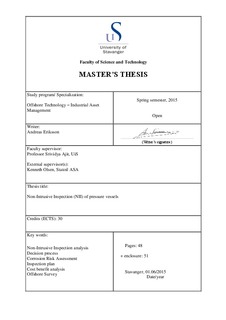| dc.description.abstract | The aim of this thesis is to identify and recommend vessels that are suitable for inspection according the NII methodology, DNV-RP-G103. The theoretical guideline used during the analysis, DNV-RP-G103, was chosen since it is the acknowledged and recommended standard in the inspection industry, and it is also according to internal technical requirements in Statoil ASA. The thesis also includes a cost benefit assessment and discussion whether or not the methodology reduces the risks at for tail production field that has been in service for over 30-years. The scope of the thesis includes all of the production vessels in one of the production trains, including the test separator. A total number of six vessels, that historical has been opened for IVI during shutdowns where this is still the chosen inspection strategy, have been selected.
This thesis is mainly divided into four parts; (1) A theoretical introduction of the NII methodology, (2) NII detailed analysis of selected pressure vessels, (3) cost benefit analysis, and (4) a discussion part followed by a final conclusion. The thesis focus on the detailed NII analysis part, since all of the data collection and decisions are performed in this section, which includes; (a) corrosion risk assessments, (b) offshore survey of the vessels, (c) collection of process and inspection data, (d) detailed NII analysis of selected vessels, and (e) selection of inspection zones and methods.
NII is not recommended for any of the vessels considered in this thesis. It is possible to perform NII of four out of six vessels after the detailed analysis, which also is supported by a cost benefit analysis that estimates IVI to be more or less about twice the cost compared to NII. However, when looking at the maintenance management loop there is a challenge in the future related to corrosion of sealing surfaces. It is possible to inspect them, but old flaws are repaired by coating and would appear as a new flaw during external inspection with NDT methods. There are not any detailed reports describing the exact location and morphology of previous defects, and this leads to a need for close visual inspection of the sealing surface, to ensure that there are not any ongoing degradation. Implementation of NII would increase the costs for inspection of these vessels, and the risks and benefits of performing NII are no longer valid. The analysis is performed for the most corrosive part of the installation, and the results may have been different if the analysis was performed in other parts of the process. However, this analysis is considered useful as a basis for analysis of other vessels onboard the installation.
During the analysis the recommended practice (RP) is considered to be a very useful guideline. It uses flow diagrams combined with detailed text and case examples that are very useful and understandable throughout the analysis. However, during the work with this thesis it has been identified sections and text that should be improved; These are (1) missing text and explanation to some of the flow chart boxes, (2) the RP states that it doesn’t consider the impact of external degradation, but it has been found to be actively used in the RP in evaluation during high level decision process and in one case example, and (3) in the coverage selection it uses the confidence of the whole corrosion risk assessment (CRA) during selection. This is misleading, and the assessment should be performed zone by zone. The author would report back the publisher, and purposed improvements of the DNV RP. | nb_NO |
